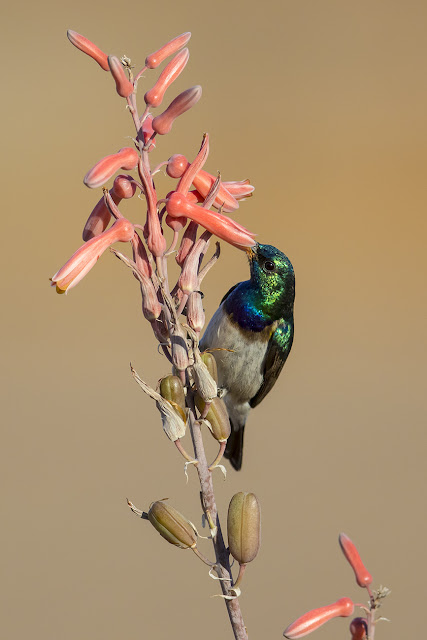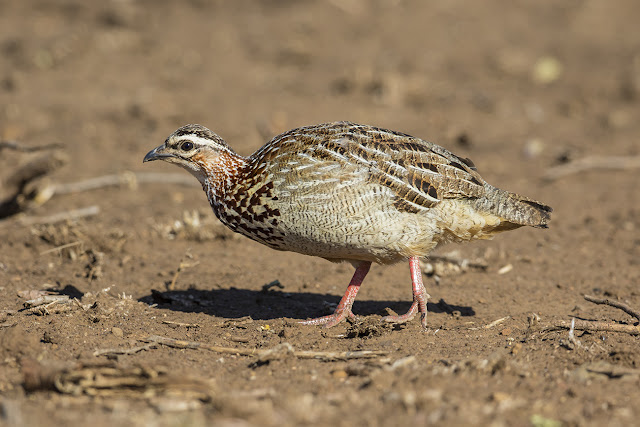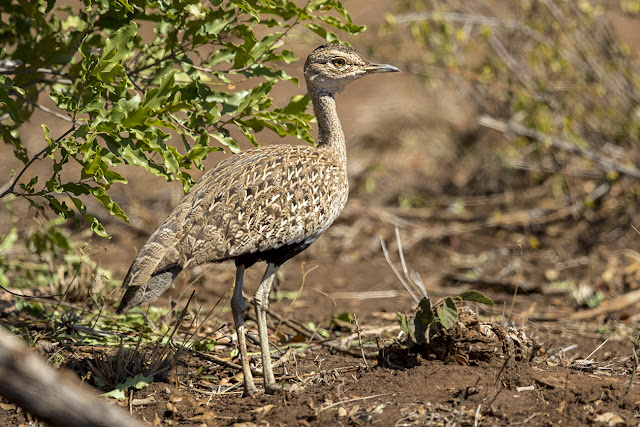Woke up to another very clear morning, it was near the end of the South African public holiday (National Women's Day I think), so we were expecting a lot less people in the park, therefore we didn't head out as early as we did the day before. After breakfast I had a good fifteen minutes just birding around the lodge's car park, a lot of aloes had been planted and most of them were just in bloom, which attracted a lot of birds. Cape White-eyes were the first bird I saw, a few had orange pollens stuck all over it's chin. Yellow-fronted Canaries also came to feed on the nectar, a species we are very familiar with as we do have a feral population in Hong Kong, it's my first time to finally see them in their natural range on this trip. A Black-backed Puffback perched on an exposed branch which allowed quite good views, this male had it's back feathers puffed out, concealing most of it's wing feathers.
Cape White-eyes - race virens
Yellow-fronted Canary - in their natural range!
Black-backed Puffback
A few trees apart, another tree was in bloom which attracted a lot of sunbirds. One of the most conspicuous being Scarlet-chested Sunbirds, a very large sunbird with an extremely eye-catching red chest and iridescent green head and throat, the female was feeding at the aloes nearby. A slightly smaller and less colourful Amethyst Sunbird was also around, but soon got chased away by it's larger neighbour, they are also known as the Black Sunbird, although in good light you will see they have purple throats and blue caps. A much smaller sunbird species with iridescent green upper parts and bluish-purple breast band was the White-bellied Sunbird, very distinctive as it's the only sunbird species in the region that got white underparts. A bright yellow bird that was also feeding on the nectar was a Spectacled Weaver, looking very smart with their black "glasses".
Scarlet-chested Sunbird - male
Scarlet-chested Sunbird - female
Amethyst Sunbird - male
White-bellied Sunbird - male
Spectacled Weaver
We said goodbye to Alan the owner of Crocodile Bridge Safari Lodge and drove to the gate, there were a lot less traffic and we were through the gate in just twenty minutes. We parked our car for a toilet break before heading into the park, but also spent some time birding in the car park area, a Southern Black Flycatcher was present, it had us mistaken it as a Squire-tailed Drongo at first, but it's darker eyes were a hint of it's true identity. A male Chinspot Batis came through, which allowed me to get some good photographs. Grey-headed Sparrows were quite common here, replacing the House and Cape Sparrows.
Crossing at Crocodile Bridge
Crocodile Bridge Gate
Southern Black Flycatcher - not a Square-tailed Drongo...
Chinspot Batis - males without any form of "chinspot"
Grey-headed Sparrow
There were more flowering aloes in the garden, which again attracted birds including more Spectacled Weavers and White-bellied Sunbirds. Just as we were about to head out, a larger bird with long tail landed right on the aloe in front of us, it's feathers shines an iridescent blue and purple under the morning sun! A Common Scimitarbill! A species closely related to Wood-hoopoes, Scimitarbills are smaller and also very different behaviorally, usually seen singly or in pairs, never in groups. The bird allowed some confiding views before it flew off the aloe and out of sight.
Spectacled Weaver
White-bellied Sunbird - male
Common Scimitarbill
We began our drive to Lower Sabie, this time taking the S28 which we hope could get us the Kori Bustard that we missed the day before. The first bird we encountered was the extremely colourful Lilac-breasted Roller, a fairly common species that we saw the day before but not close views. When seen under good lighting, it's arguably one of the most spectacular looking bird in all of Kruger, it's multiple shades of blue, green, pink and purple all reflected gloriously under the morning sun. A Red-billed Oxpecker perched on an Impala provided great views of this peculiar bird.
Lilac-breasted Roller - easily the most colourful bird at Kruger
Impala with Oxpecker
Red-billed Oxpecker
With smaller trees and much more open grassland then the main road, the S28 is a good route for open country species that prefers shorter grassland. Two species of Lapwings made an appearance in succession. First a flock of Crowned Lapwings which are easily recognised by their black brows with black and white crown stripes, then soon after we encountered a small flock of Senegal Lapwings, much smaller in size and have diagnostic white foreheads, they are considered an uncommon resident in it's range. A few smaller birds on the ground were Sabota Larks and African Pipits, both very well camouflaged amongst the dried grass, a more conspicuous Capped Wheatear hopped around searching for food.
Crowned Lapwing
Senegal Lapwing
Sabota Lark
African Pipit
Capped Wheatear
One of the most common species though out South Africa must be Cape Collared Doves, they can be seen in all types of habitats, and are no less uncommon in rural Kruger then urban Johannesburg. A few Crested Francolins came right out in the open for some very good views.
Cape Collared Dove
Crested Francolin
S28 also proved to be quite good for mammals, we had multiple herds of Blue Wildebeests, most of them quite close to the road. Warthogs were very common along here, and Plain Zebras were seen in quite good numbers. We spotted a pair of large bird perched on a road side tree, closer inspection revealed them to be a pair of White-backed Vultures, they allowed some fairly close shots to be taken.
Blue Wildebeest
Warthogs
Plain Zebras
White-backed Vultures
We encountered another species of resident Roller along here, the Purple Roller is much duller then it's cousin, but you will begin to appreciate it's purplish orange underparts and wings when you get a better look. As we got near to Lower Sabie, we saw a bird in the thickets, one of them had a bright orange head with bluish grey back, these colours resembles an Orange-headed Thrush! Although it was quite obvious it was in fact a Red-capped Robin-Chat.
Purple Roller - the less common resident Roller
Red-capped Robin-Chat - Orange-headed Thrush of Africa!
We decided to go for only a quick lunch at Lower Sabie as we had plenty of miles to catch up to on our way to Satara. The short lunch break was in fact quite productive with birds, my guess was that less visitors meant the birds were easier to see in the rest camp. A large and colourful Grey-headed Bushshrike went down to a fountain to drink. The same fountain attracted a Black-collared Barbet which gave very confiding views this time round. Dark-capped Bulbuls were actively feeding at flower aloes. A flock of gregarious Arrow-marked Babblers fed noisily next to the restaurant's viewing platform.
Grey-headed Bushshrike - a very large headed and colourful Bushshrike
Black-collared Barbet
Dark-capped Bulbul
Arrow-marked Babbler
After lunch, we headed north across the Sabie river, at the crossing we noticed a huge heron at the side of the bridge, the Goliath Heron is the world's largest heron, measuring up to 152cm and wingspan of 230cm, this is a bird hard to miss. They are confined to larger rivers within Kruger, usually seen perched on rocks along the river banks. A Great Egret and African Spoonbill were present not too far away. You could see Nile Crocodiles lurking in the water below.
Sabie River
Goliath Heron - largest heron in Africa!
Great Egret & African Spoonbill, Waterbuck in front.
Nile Crocodile
We followed the H10 towards Tshokwane picnic site, we encountered our first Bustard along this road, unfortunately it was not a Kori, but a much smaller and more common Red-crested Korhaan. They are quite inconspicuous and can stand motionlessly on the ground, they are well camouflaged in the savanna, their colours blends in with their surroundings very nicely. Swainson's Spurfowls were very common along this route, we even encountered a family of them, some of them obviously still juveniles.
Red-crested Korhaan - my first Bustard!
Swainson's Spurfowls
We got to an area with quite a few White Rhinos, most of them giving very good views, including a mother and her calve. Although they are considered to be the most numerous Rhinoceros species in the world, there are estimated to be no more then 20,000 individuals left in the wild. They nearly went extinct in the late 19th century, a small population of around 100 individuals were discovered in South Africa in 1895, and protection and conservation of the species had increased their numbers to what they are today. Although they have been brought back from the brink of extinction, poaching for their valuable horns is still threatens their survival.
We caught up with the other two cars viewing the rhinos, Captain asked me whether we saw the flock of Southern Ground Hornbills just a few hundred meters back, my heart sank immediately...We made a quick U-turn to look for the flock, but came up empty handed. We were probably just late by about five minutes, and it's frustrating to have such rotten luck after having missed the Kori Bustard just the day before, and now we have missed another major target! This will no doubt goes down as the "dip of the trip"!
Southern White Rhinoceros
A couple of Rollers of both species barely cheered me up, although they did provided wonderful views and were particularly photogenic. I am sure they would have shown their sympathy for me if they knew what I've just dipped on.
Purple Roller
Lilac-breasted Roller
Further along the road we encountered a feeding frenzy of Vultures! They were feasting on what look to be a baby Elephant, the flesh and skin on it's head had nearly been completely stripped bare, revealing the skull beneath. Most of the Vultures present were White-backed Vultures, but a few Lappet-faced Vultures were there as well, resting on the side, they have probably had their shares earlier. We noticed an adult Elephant pacing back and forth in the background, it was probably the deceased Elephant's parent. As one of the most intelligent mammals, Elephants are known to be able to feel grief amongst many other emotions.
White-backed Vulture feeding on Elephant calve
Lappet-faced Vulture
A mourning Elephant
A Verreaux's Eagle Owl (Giant) found roosting on a large tree next to the road was a bonus! It certainly made me slightly happier about the dip earlier. This is the largest owl of the region, measuring up to 66cm! Their pink eye-lids are one of the main diagnostic feature.
Verreaux's Eagle Owl - Giant Eagle Owl seems the much more suitable name!
We soon arrived at Tshokwane, a place to stretch our legs and get a few sandwiches. The picnic site is a popular stop over for visitors, and with people there are food, with food there are birds. Southern Yellow-billed Hornbills frequents the camp site where they look for leftovers from picnickers. Greater Blue-eared Starlings were the most common species here, you will see them all over the place! Laughing Doves fed along the ground, along with the slightly larger African Mourning Doves.
Tshokwane Picnic Site
Southern Yellow-billed Hornbill
Greater Blue-eared Starling
Laughing Dove
African Mourning Dove
Back on the road we encountered a Southern Red-billed Hornbill, another common species similar to the Yellow-billed but with somewhat smaller and have thinner bills, easily told apart by their different bill colour. We didn't see that many more birds, only a Rattling Cisticola allowed anything remotely decent.
Southern Red-billed Hornbill
Rattling Cisticola
Greater Kudus were quite common along this stretch, feeding on the side of the road. We got to a water hole and found a herd of Elephants drinking and bathing, a few young bulls were even fighting each other, although I wasn't sure whether they were being serious or not, but it was still to see two huge animals engaging in trunk wrestling; one will try to push the other's head downwards with their powerful trunk.
Greater Kudu
African Elephant - trunk wrestling
We soon reached Satara Rest Camp before night fall, the camp grounds were lightly wooded with lodges dotted all around the camp, a few Warthogs were feeding at the car park, somehow gotten themselves into the safety of the other side of the electric fence! After checking in and settled into our rooms we took a stroll outside our lodge, the circular garden provided a nice common area, a few Banded Mongoose came foraging around the lodges.
Lodge area at Satara Rest Camp
At dinner, we were told Sammy felt quite ill and needed some rest in his room. The packed schedule must have taken a toll on some of us, everyone felt a little tired so we decided to not go on the night safari that night. After dinner (Mugg & Bean again!), Yuen and Captain went outside to take some photographs of stars, while my Dad and I decided to look for the African Scops Owl that was calling not too far away. Satara have long been known to be the best camp to look for African Scops Owls at Kruger, although they are common throughout the park, they are supposedly most numerous at Satara. We walked along the camp site, listening out to where the calls were coming from, but decided it was coming too far into the staff quarters which were out of bounds. I played a burst of playback to see if any other individual respond, surely enough another Owl responded, this time much closer to where Captain and Yuen were taking photographs. We narrowed down the call to a single tree on the lawn, Captain and Yuen were already aware of the calling Owl and came to look for the bird. We scanned the tree with our torches and soon found the tiny Owl perched on a branch just a two meters above us! We all managed some wonderful views, including Erica and Captain's daughter. Interestingly we managed to see the largest and one of the smallest South African owls on the same day!
African Scops Owl
To be continued...














































































No comments:
Post a Comment